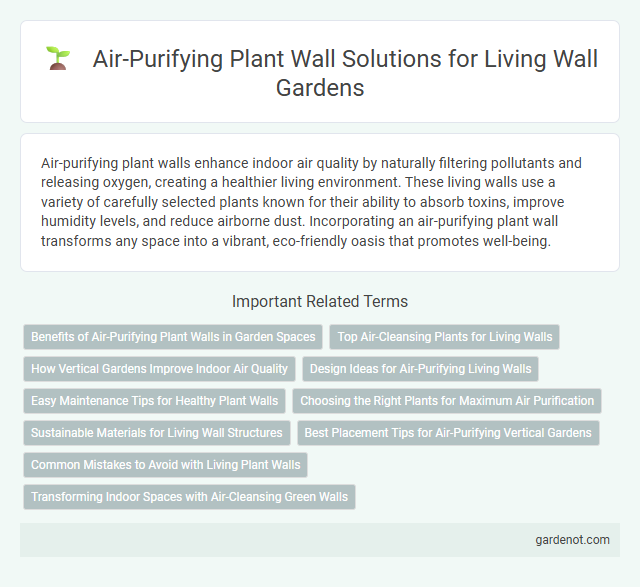Air-purifying plant walls enhance indoor air quality by naturally filtering pollutants and releasing oxygen, creating a healthier living environment. These living walls use a variety of carefully selected plants known for their ability to absorb toxins, improve humidity levels, and reduce airborne dust. Incorporating an air-purifying plant wall transforms any space into a vibrant, eco-friendly oasis that promotes well-being.
Benefits of Air-Purifying Plant Walls in Garden Spaces
Air-purifying plant walls in garden spaces enhance air quality by filtering pollutants and releasing oxygen, creating a healthier environment. These living walls also improve humidity levels and reduce airborne dust, contributing to overall well-being. Incorporating species like spider plants, peace lilies, and Boston ferns maximizes the air-purifying benefits while adding natural beauty to outdoor areas.
Top Air-Cleansing Plants for Living Walls
Top air-cleansing plants for living walls include spider plants (Chlorophytum comosum), known for removing formaldehyde and carbon monoxide, snake plants (Sansevieria trifasciata) that filter out benzene and trichloroethylene, and pothos (Epipremnum aureum), which efficiently absorbs toxins and improves indoor air quality. Boston ferns (Nephrolepis exaltata) and peace lilies (Spathiphyllum) are also highly effective, reducing airborne mold spores and volatile organic compounds (VOCs). Incorporating these species into a living wall enhances air purification while providing aesthetic greenery in indoor environments.
How Vertical Gardens Improve Indoor Air Quality
Vertical gardens significantly enhance indoor air quality by incorporating air-purifying plants such as spider plants, peace lilies, and snake plants, which absorb pollutants like formaldehyde, benzene, and carbon monoxide. These living walls increase oxygen levels and humidity, creating a healthier atmosphere and reducing respiratory issues. Integrating vertical gardens into indoor spaces effectively filters airborne toxins and promotes overall well-being.
Design Ideas for Air-Purifying Living Walls
Incorporate a variety of air-purifying plants such as spider plants, peace lilies, and Boston ferns to maximize indoor air quality while enhancing aesthetics. Use modular panels or vertical garden systems to create customizable living walls that fit different spaces and lighting conditions. Integrating LED grow lights ensures healthy plant growth in low-light environments, making the living wall both functional and visually appealing.
Easy Maintenance Tips for Healthy Plant Walls
Air-purifying plant walls thrive with consistent watering schedules and adequate indirect sunlight, ensuring healthier foliage and improved air quality. Utilizing well-draining soil mix and regular pruning prevents root rot and encourages new growth for a lush appearance. Incorporating slow-release fertilizers every few months supports nutrient balance critical for vibrant, long-lasting living walls.
Choosing the Right Plants for Maximum Air Purification
Choosing the right plants for an air-purifying living wall involves selecting species known for their ability to filter toxins and improve indoor air quality, such as spider plants, pothos, and peace lilies. Incorporating a diverse mix of plants with various leaf structures and sizes enhances the wall's capacity to absorb pollutants like formaldehyde, benzene, and carbon monoxide. Ensuring proper humidity and light conditions tailored to each plant species maximizes their air-cleaning efficiency and longevity within the vertical garden.
Sustainable Materials for Living Wall Structures
Living wall structures utilizing sustainable materials such as reclaimed wood, recycled metal, and biodegradable polymers significantly reduce environmental impact while enhancing air purification efficiency. Incorporating natural substrates like coconut coir and peat-free growing media supports plant health and promotes microbial activity crucial for breaking down airborne toxins. These eco-friendly materials not only ensure durability and moisture retention but also align with green building certifications, making air-purifying plant walls a sustainable solution for improving indoor air quality.
Best Placement Tips for Air-Purifying Vertical Gardens
For optimal air-purifying effects, place vertical gardens near high-traffic areas where indoor pollutants accumulate, such as living rooms or offices. Ensure the wall receives indirect natural light to support plant health without causing stress or dryness. Positioning air-purifying plant walls close to HVAC vents or air circulation points enhances their ability to filter and improve indoor air quality effectively.
Common Mistakes to Avoid with Living Plant Walls
Overwatering and poor drainage are common mistakes that undermine the health of air-purifying living walls, leading to root rot and mold growth. Neglecting proper light exposure can cause plants like spider plants or peace lilies to weaken, reducing their air-filtering efficiency. Ignoring regular maintenance such as pruning and pest control can compromise the plant wall's ability to remove toxins like formaldehyde and benzene from indoor air.
Transforming Indoor Spaces with Air-Cleansing Green Walls
Air-purifying plant walls significantly enhance indoor air quality by filtering pollutants and increasing oxygen levels through natural photosynthesis. Integrating green walls into living spaces reduces airborne toxins such as formaldehyde, benzene, and nitrogen dioxide, promoting healthier environments. These biophilic installations not only improve air cleanliness but also elevate aesthetic appeal and psychological well-being in homes and offices.
Air-purifying plant wall Infographic

 gardenot.com
gardenot.com